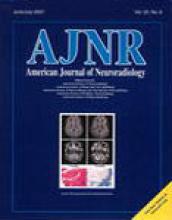In this issue of the AJNR, Bozzao et al (page 1030) evaluated the sensitivity and specificity of functional MR (fMR) imaging in presumed Alzheimer's disease (AD) by comparing fMR results with those of minimally invasive contrast-enhanced perfusion scanning, diffusion-weighted scanning, and conventional MR imaging.
Significant differences were shown in regional CBV (rCBV) values derived by perfusion scanning when mildly and moderately impaired patients with a presumed diagnosis of AD were compared with a group of healthy aged-matched control subjects. Regional CBV values of presumed specificity measured as high as 91%. The authors also applied an atrophy correction to the perfusion measures, which reduced the strength of the results, but all the correlations remained significant. Diffusion scanning did not yield any significant correlations, and no correlates were found for white matter lesions (referred to by the authors as “lesion load”).
This study exemplifies the exciting transition that we are witnessing in brain behavior research in which complex brain function such as brain metabolism and blood flow are being evaluated by minimally invasive techniques such as fMR imaging. Positron emission tomography (PET), until now considered the penultimate of brain behavior research, requires intravenous injection of a positron emitter as well as arterial cannulization of the patient. During a 20-minute uptake period, a positron-emitting molecule such as the glucose analog F18 fluoro-deoxy-D-glucose or carbon 11 deoxy-D-glucose is trapped at the stage of phosphorylation while emitting positrons. Each positron collides with a negatively charged electron, forming coincident photons travelling in opposite directions that are measured by the detectors. Thus, a measure of glucose metabolism is obtained that, with the use of an operational equation, yields quantitative metabolic measures.
Glucose metabolism and perfusion or blood flow is not dissociated in the presence of Alzheimer disease. This coupling allows us to use alternate techniques such as single-photon emission tomography (SPECT) or perfusion MR scanning to measure CBV or rCBV, and indirectly, cerebral metabolism.
Results of PET measures have shown decrements of up to 30% to 35% in glucose metabolism in moderate AD versus those of healthy age-matched control subjects. The most pronounced deficits involve the hippocampi and the temporal and the parietal lobes. The perfusion results in the present study seem to be comparable, showing rCBV decrements as high as 47% for the left hippocampal region. Sensitivity and specificity measures derived from PET for the diagnosis of AD are in the 80% range. In the current study, Bozzao et al achieved sensitivity measures as high as 91% in the identification of moderately impaired patients with a presumed diagnosis of AD. These results are very encouraging and suggest that perfusion MR may be at least as sensitive as PET in the diagnosis of AD and in the identification of subjects who are likely to develop AD at 3- to 5-year follow-up. This is particularly important, because Food and Drug Administration–approved treatments are available that may retard, arrest, or delay symptoms of AD.
What, then, are the shortcomings, if any, to using perfusion scanning routinely in dementia if not more widely to help identify patients at risk?
Perfusion MR allows us to measure rCBV, but are these measures truly comparable to PET measures? MR perfusion measures and SPECT are not quantitative. For this reason, various strategies have been devised to compensate for the subjective nature of the results. The authors' strategy of using the cerebellum as a reference measure is made on the basis of SPECT research in the literature. There are, however, pitfalls with this strategy. For example, Klinger et al (1988) found that PET determined cerebellar metabolic rates were elevated in subjects with periventricular white matter disease and Ishii et al (1997) reported that in advanced Alzheimer disease cerebral as well as cerebellar glucose metabolism measures are decreased. Thus, we can approximate quantitative measures by using fMR, but there is a potentially limiting error built into the method.
There is an important weakness in brain behavior research studies that derive measures of brain (volumes, perfusion data, proton spectroscopy) and either correlate them with behavior measures such as the Mini Mental Status Examination or use them to identify pathologic abnormality. When we attempt to answer the question “is this subject a member of the AD group or the control group?”, we obtain impressive results. Unfortunately, this type of question, posed in a research setting, is markedly different from the questions posed in the day-to-day reading of a stack of films. In the latter setting, many potentially dementing diseases, including Parkinson disease and vascular dementia, are considered.
In addition to PET and SPECT studies, structural MR studies such as volumetric assessments of the temporal lobes by means of thin-section cuts, and CT studies before that, have also shown strong correlations between hippocampal atrophy and cognitive measures and excellent accuracy in discriminating between AD and normal subjects. Recent proton MR spectroscopy reports have shown correlations between metabolite measures and cognitive deficits. A simple clinical measure, such as delayed paragraph recall, can predict subsequent decline in approximately 80% of subjects. One might ask why we should pursue yet another complex technique to accomplish similar results.
It would appear that we are not quite ready to diagnose AD in a routine clinical setting, but we can identify patients who may have or are at risk to develop the disease. What may be very useful at this stage is to attempt to sort out the relative contribution of the multiple studies at our disposal. It would be particularly interesting to determine whether the structural measures, such as hippocampal volume, are independent of perfusion deficits, and whether the perfusion measures provide additional diagnostic information independent of the hippocampal atrophy. The authors did in fact apply an atrophy correction for the whole-brain perfusion measures, but a regional atrophy correction would be particularly interesting because of the well-known sensitivity of hippocampal atrophy to AD.
- Copyright © American Society of Neuroradiology












